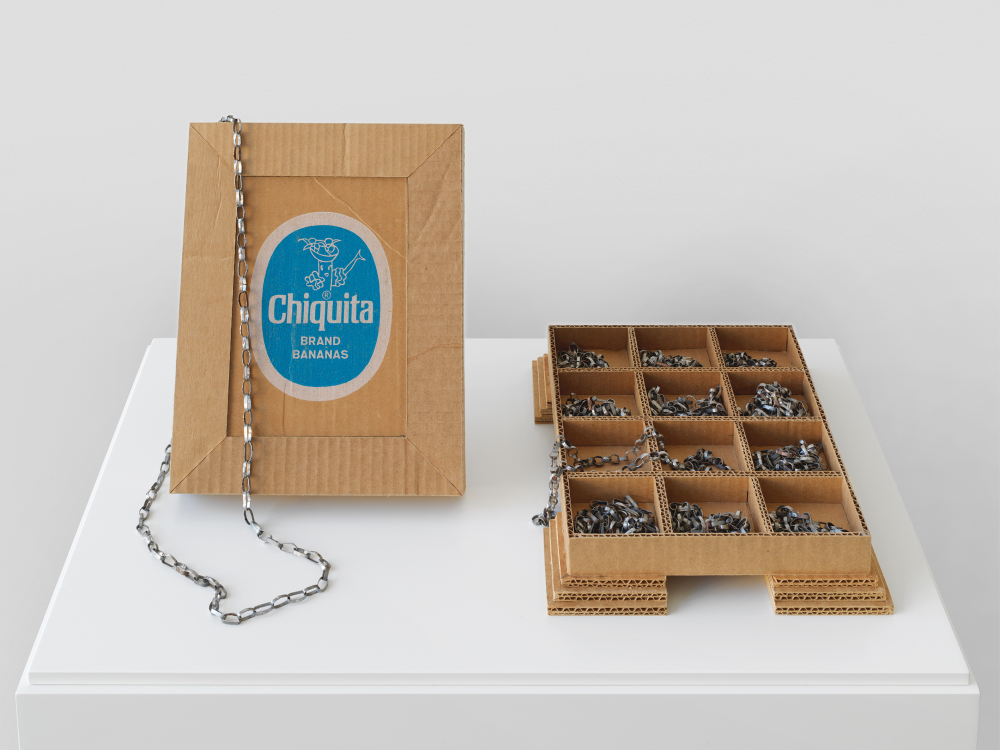Zurich – Anyone who enters the solo exhibition of renowned Swiss artist Jean-Frédéric Schnyder (b. 1945) at Galery Eva Presenhuber initially feels like a giant in a dollshouse. Or like King Kong confronted with a cardboard Empire State Building.
Around 160 pictures, oil on plywood, which decorate the white gallery walls like a frieze, are aptly entitled ‘Kleine Bilder’ (small pictures). Schnyder’s works – he represented Switzerland at the Venice Biennale in 1993 – are remarkably modest: most are less than 20 x 20 centimeters large. The pictures have cardboard frames and are in small groups, each with a letter (A-Z) in the title. After a sweeping look it strikes you: the subjects, even though rendered in oversized pixels, seem strangely familiar! Although the blocky style refers to a digital age – possibly also to virtual worlds – they equally reference bygone eras: a skull is reminiscent of the Baroque period and the vanitas genre, while flowers and still lifes with wine glass and pitcher make one think of the 19thcentury modernity, of Cézanne and Matisse. Sunsets can be read in relation to the Swiss painters Felix Vallotton or Ferdinand Hodler, the latter having already inspired earlier works by Schnyder. The series of pictures seems to be a broad historical outline of milestones in art: from ornaments and swastikas to Claude Monet’s Impressionist studies and Gerhard Richter-like pictures; Schnyder entitles the series ‘Anhang A-Z’. Rendered in pixels, the individual figurative and abstract motifs seem childish, almost banal or kitsch. A criticism of today’s technically-focused world? A warning about a future in which art works two-dimensionally and digitally and life in general will take place virtually via screen?
Cardboard objects are placed on 5 low white pedestals, underlining the question of value and loss of value in the course of (art) history: on one, a group of ancient cathedrals with domes and turrets, on another a settlement of identical single-family dwellings, the Empire State building in between. The cardboard – an everyday material – catapults different architectural styles into the consumption-oriented contemporary and juxtaposes them. At the same time, the brown, re-used packaging-material strips a little magic from the Baroque and Gothic cathedrals, which ‘really’ owe their appeal from their marble, ornaments and gilding. The cardboard also makes the single-family dwellings all the more sterile and drab. At the same time, the diminutive, perfectly constructed buildings are a humorous reminder of building kits, and thus of childhood.
Nostalgia surfaces, prompting a reflection on temporality, materiality and the future. What at first appeared like a playroom turns out to be a profound conceptual oeuvre. The significance and the play on the question of appearance and being are not least evident in the work ‘CHIQUITA’, which consists of a cardboard box and a metal chain made from the staples in the box. The chain is positioned in the box as if it were a precious piece of jewelry. In this setting, however, the ‘most valuable’ thing, one could say, is absent: the bananas that once were inside the cardboard box – while the artwork that survives here basically consists of a fake piece of jewelry and a piece of cardboard. The work shows wonderfully how the concept on which a work of art is based makes it what it is and that the real value of the thing lies in the imagination and thoughts which the object may stimulate. Ultimately Schnyder’s workis ambiguous – hovering between humor, symbolism and politics – and invites the viewer to dive in and be critical about the art world and society at large.

